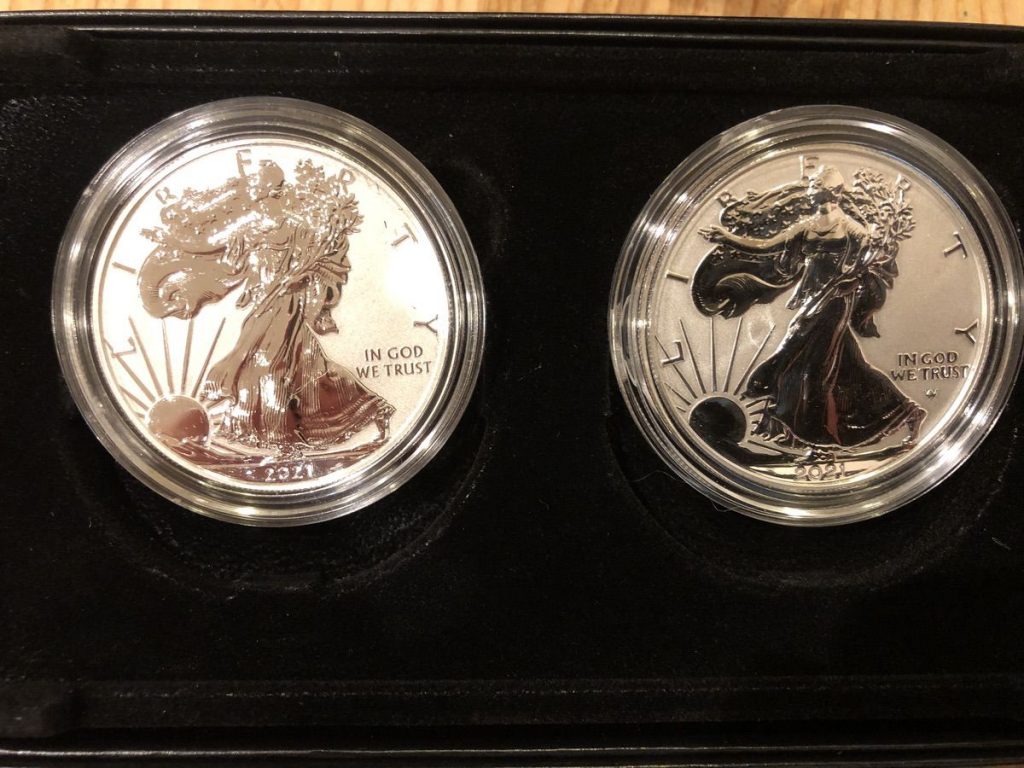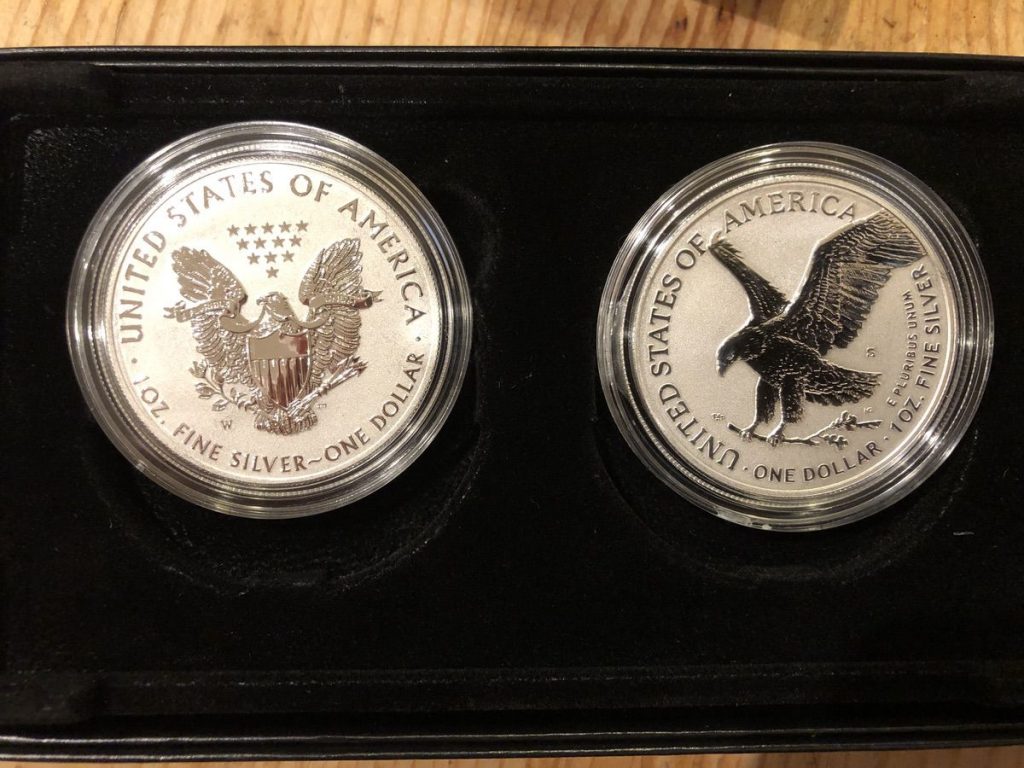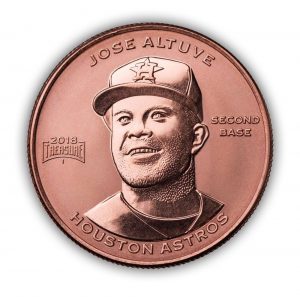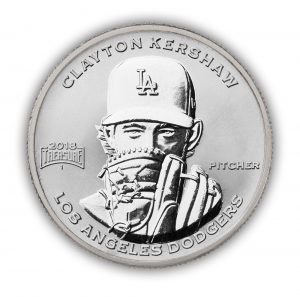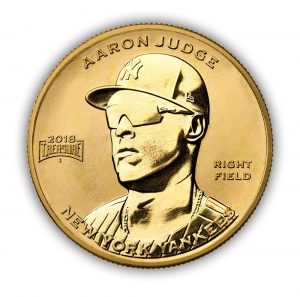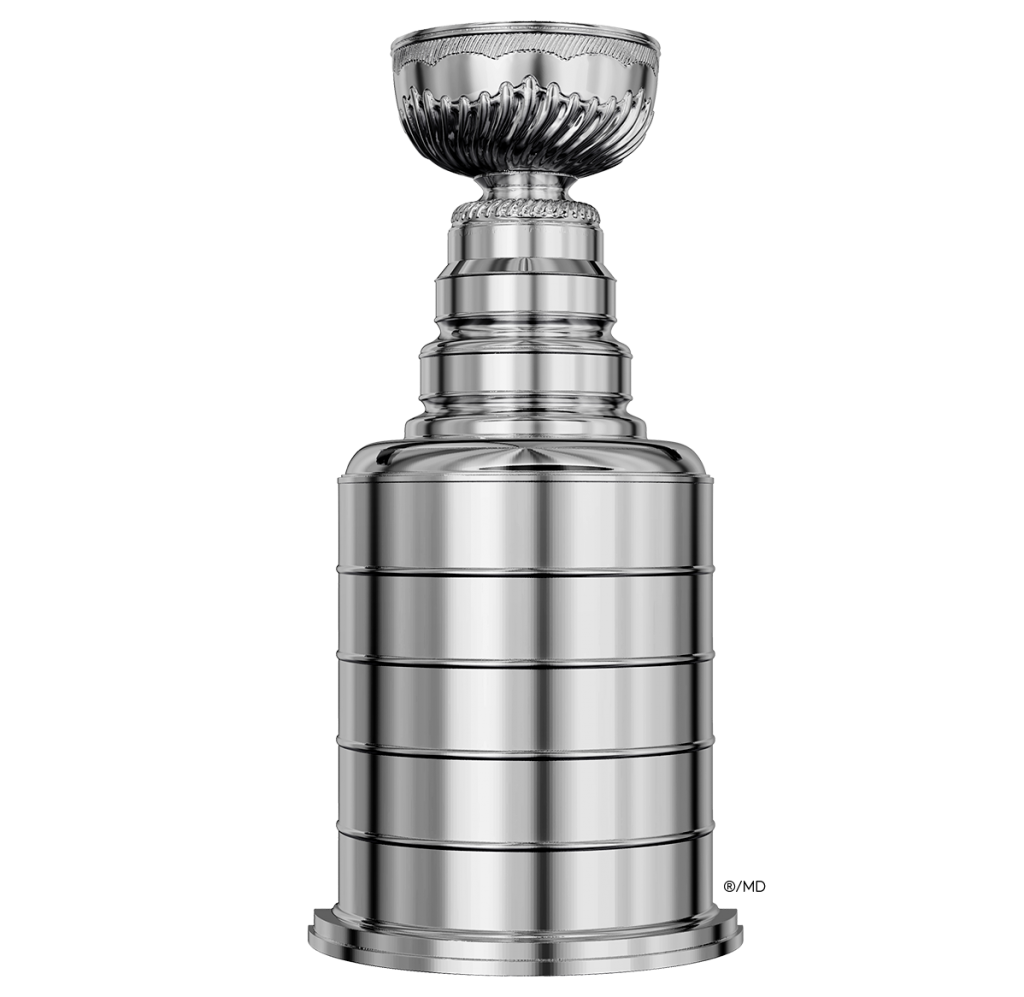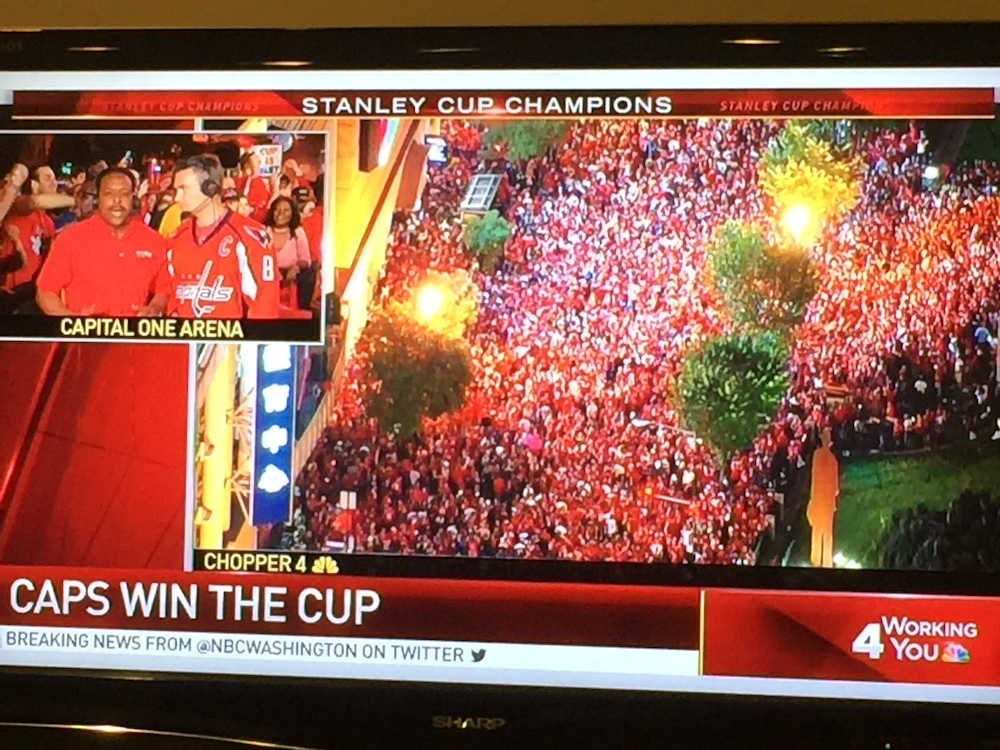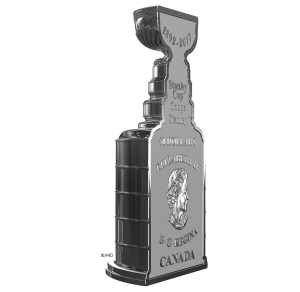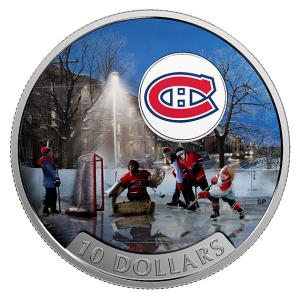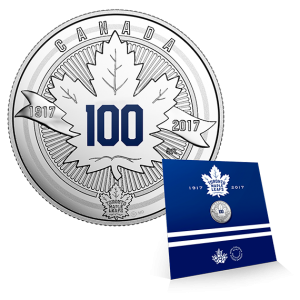Keeping my ASE Proof Collection Complete
With everything that is going on, coin collecting is still a fun hobby, and there are a lot of coins to collect. I am proudest of my almost complete collection of proof American Silver Eagle coins.
From 1986 to 2019, my father bought two proof American Silver Eagle coins. One was for his collection, and the other was mine. When the U.S. Mint issued special sets, I would purchase one for myself and attempt to purchase one for my father. I was able to purchase the 25th Anniversary Set for myself but could never buy one for my father. On the secondary market, too many sets were broken up and graded, ruining the grandeur of the five-coin set.
I am missing the 1995-W American Silver Eagle.
Although there have been problems with the U.S. Mint’s e-commerce site, I have been able to keep up with my American Silver Eagle collection. Recently, the U.S. Mint shipped the American Silver Eagle Reverse Proof Two-Coin Set. My set arrived before I left town for the weekend.
Like many collectors, I love the look of reverse-proof coins. The shiny devices make the design stand out. When I show the coins to non-collectors, the coins make an impression.
What does not make an impression is the package.
For a set that costs $175, the package feels cheap. The insert is cheap plastic that holds onto the coin so tight that the coin is difficult to remove. The box is thinner cardboard, and it is not in a clamshell box, like other sets. The package appears as if the U.S. Mint modified it from a copper-nickel clad proof coin.
The U.S. Mint might think that the package does not matter. There will be collectors that will take the coins out of the package and send them to a third-party grading service. This attitude does not consider those who prefer to keep the coins in the original government package (OGP).
My entire collection of American Silver Eagle proof coins is in its OGP. The 2021 set looks like an afterthought next to the 2013 West Point and 2012 San Francisco two-coin sets.
At least the coins are gorgeous!
Meme Monday!
During a quick diversion on Facebook after posting a job for my new business, I found this post. I think it is appropriate for everyone!
I hope your Monday was as exciting as finding an Indian Head cent in your coin roll!
If not, have another cup of coffee and try again on Tuesday! 😉
Weekly World Numismatic News for June 10, 2018
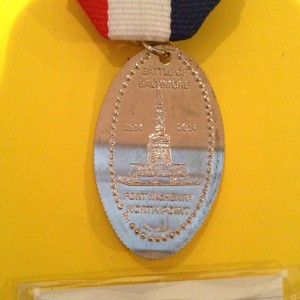
Elongated 2013 Fort McHenry quarter that was part of the Maryland Token and Medal Society souvenir card
This is where our article feature article, “Pressing Memories: Pursuing elongated coins won’t break the bank,” in Antique Trader is appropriate. It tells the story about the origin or elongated coins and the current market for these coins.
One way to consider collecting elongated coins is to collect them based on where you have been. While some people will buy postcards or lapel pins to collect as souvenirs, elongated coins can be less expensive and have even more variety than gift shop fare.
You can find the machines with the cranks that will create elongated coins in a lot of museums, theme parks, and even in on the Disney properties. Most machines charge 51-cents to $1.01 to squish and imprint a design on the one-cent coin you pay for the service. Almost all of the machines are mechanical where you do the work. They also will only elongate cents. There are a few machines that are more automated that can elongate almost any coin.
Having played around with a few of these machines, the best coin to use is one of the copper-plated zinc cents (post-1982) that is red-brown in color with more red than brown. Very shiny coins look too artificial and the design seems to get lost on brown cents. One of the reasons not to use the all-copper cents is that the rich brown that makes those cents attractive does not look as good when squished.
If you start to collect elongated coins you may consider joining The Elongated Collectors (TEC) organization. Considering that elongated coins are fun collectibles, TEC has to be a fun group. Join in and have fun!
And now the news…
By Karen Knapstein You don’t need to have an interest in coin collecting to get started in coin collecting. If you are a traveler, a fun-seeker, a keeper of mementos from family outings or historical events, creating and collecting elongated pennies may be a good fit for you.  → Read more at antiquetrader.com
→ Read more at antiquetrader.com
Before you tell me I am cuckoo, allow me to introduce Ian Watt. The 70-year-old from the United Kingdom has made the enormous amount of money in a very peculiar way. Mr Watt’s fortune has come from him never walking past a coin on the ground, with the eagle-eyed dad collecting almost a million of lost coins in his travels.  → Read more at news.com.au
→ Read more at news.com.au
Patna: The Reserve Bank of India (RBI), in view of the coin glut in Bihar, said on Monday that the central government was encouraging use of coins, and it was receiving two to four truckloads of coins daily in Patna to be distributed across the state through banks.  → Read more at telegraphindia.com
→ Read more at telegraphindia.com
(Kitco News) – The gold market continues to struggle with weak bullion demand as the Royal Canadian Mint reported a more than 50% drop in sales in the first quarter of 2018. In its first-quarter earnings report, released last week, the Canadian mint said that gold volume dropped to 108.5 thousand ounces in the first quarter, down from 228.2 thousand ounces reported in the first quarter of 2017.  → Read more at kitco.com
→ Read more at kitco.com
The Singapore Mint has released a limited-edition set of medallions to commemorate the historic first summit between a sitting U.S. president, Donald Trump, and a North Korean leader, Kim Jong Un, scheduled in the island state for June 12.  → Read more at newsweek.com
→ Read more at newsweek.com
Exploration company Golden Predator plans to start selling the coins — about $1,800 for a one-ounce coin — later this month.  → Read more at cbc.ca
→ Read more at cbc.ca
The Mint continues to tap in to its creativity and innovation to further unleash the  → Read more at globalbankingandfinance.com
→ Read more at globalbankingandfinance.com
New Baseball Medals
Keeping with this week’s theme of sports on coins, a company named Baseball Treasure (at baseballtreasure.com) created baseball “coins,” technically medals, representative of all 30 teams. Each team is represented by one player whose likeness will appear on the medals.
These medals are licensed by Major League Baseball and the Major League Baseball Players Association.
Most of the medals are made from one ounce of copper. The medals are mounted on a baseball-card-sized cardboard card with player highlights, similar to what you would see on a baseball card.
The medals are sold in packs of three, six, and nine—or you will receive multiple packs of three medals. You can buy a box containing 36-packs. Assuming a pack contains three medals, their “Treasure Chest” contains 108 medals. For $3,000 you can buy a 12 box package with 432 packs containing 15,552 medals.
According to their website, one in every 432 packs will have a version of the medal made in .999 silver. Silver medals have been struck for each of the 30 players.
If you want to go for the gold, one in every 21,600 packs contains a specially marked medal redeemable for a gold medal featuring Aaron Judge of the New York Yankees. This was created to commemorate his rookie record of 52 home in the 2017 season.
- José Altuve of the Houston Astros Copper Medal
- Clayton Kershaw of the Los Angeles Dodgers Silver Medal
- Aaron Judge of the New York Yankees Gold Medal
For those who are into trivia and would like to win a silver medal, they will post a clue on social media with the answer being a major league team. If you want more information, visit their #JoinTheHunt webpage for more information.
Previously, Upper Deck created hockey coins that they sold for $100 per coin on a virtual basis. While you could request the physical coin, they created a system to buy and trade these medals. There was also the chase to find the gold versions in this series.
The hockey coins are legal tender coins in the Cook Islands.
I had interviewed the Vice President involved in the program and just could not bring myself to write about the interview because I was very skeptical about how the program worked. Initially, they were sold in what they called e-Packs, virtual packages that would be held by Upper Deck. From the e-pack website, collectors can trade with each other.
One of my issues with this program is that they are sold blind packaged like baseball cards. You do not know what is in the package until it is opened. At $100 you can receive either a one-ounce silver coin, one-ounce high relief coin, one-ounce silver frosted coin, or a quarter-ounce gold coins. It would be a real bargain if you received a gold. It would be a worse deal than many Royal Canadian Mint silver coins otherwise.
Visiting their website recently, there is an option to purchase the coins at Canadian Imperial Bank of Commerce (CIBC) throughout Canada. There is no option to physically purchase coins in the United States except through the e-pack website.
These coins must be selling well enough for Upper Deck to continue the program.
In both cases, I am just not impressed with either program.
Both programs are over-priced.
The Baseball Treasure program is selling one-ounce of copper medals at $6.65 each. With the current copper price of $3.2858 per pound, each coin contains 20.5-cents of metals. The rest is packaging, licensing, and distribution. Even so, that is a 3,123,9-percent markup that you may never make up on the secondary market if you were to lose interest, especially since this is a medal and not a legal tender coin.
Of course, it is a better deal if you found a silver or gold medal. Then again, part of the markup to the copper medal is subsidizing the silver and gold medals. Without knowing how many medals or packages are being produced, it is difficult to determine how much of the $6.65 price is subsidizing the gold and silver.
Baseball Treasure’s program is certainly a more interesting idea than the Upper Deck Hockey Coin Program. It is more affordable and carries less risk. The Treasure Hunt also looks like fun and maybe something I will look into. But for now, it is not something I will collect. But if you do be aware that the copper medals may not return much more than $1-2 on the secondary market, depending on the price of copper.
#ALLCAPS
Ice Hockey and Lord Stanley’s Cup highlighted with numismatics
Hockey is to Canada as baseball and basketball is to the United States.
Although all sports are represented throughout North America, ice hockey is purely a Canadian invention. Although there are records of hockey being played as far back as ancient Egypt, the first appearance of hockey played on the ice dates to the early 19th century in Nova Scotia.The early game was derived from the North American Natives game of shinney but played on the ice. From Nova Scotia, the game spread to the people living along the Saint Lawrence River in Montreal and Quebec. It quickly spread west to Ontario.
Montreal is to hockey as Springfield, Massachusetts is to basketball. The first organized games were played in Montreal where the first organized rules were formed. The first ice hockey club was the McGill University Hockey Club founded in 1877. This was followed by the Quebec Hockey Club in 1878 and the Montreal Victorias in 1881.
Lord Stanley of Preston, the Governor General of Canada, attended his first game in 1888 with his children who were hockey fans. Lord Stanley became a fan and noticed that there was no championship trophy awarded to the best team in Canada. He purchased a silver bowl to use as a trophy and created The Dominion Hockey Challenge Cup. It was first awarded in 1893 to the Montreal Hockey Club.While ice hockey was dominating in Canada, universities in the United States had their own version of ice polo played with a ball rather than a puck. The first game between collegiate hockey clubs was played in 1893 in Baltimore when Yale beat Johns Hopkins 2-1.
Lord Stanley’s sons were so enthusiastic about hockey that they traveled the world to introduce the sport to others. By 1903 they organized a five-team European league.
The Western Pennsylvania Hockey League was formed in Pittsburgh in 1898 which primarily operated in areas within a four-hour train ride from Pittsburgh. Most of the professional players were from Canada. In 1904, a rival International Professional Hockey League was formed to include Canadian cities.
With all of the competing leagues, the National Hockey Association was formed in 1908 to organize professional hockey in the provinces of Quebec and Ontario. With western Canada feeling left out, the Pacific Coast Hockey Association (PCHA) was formed to stretch professional hockey across Canada. The two leagues negotiated a championship between them that the winner of the series would will what was then being called the Stanley Cup first awarded by Lord Stanley.
World War I and a dispute between the owners and Toronto Blueshirts owner Eddie Livingstone saw the fall of the NHA in 1917. As part of their attempt to reorganize, owners formed the National Hockey League. The NHL was supposed to be a temporary measure until disputes were worked out but its success continues.The original NHL included the Montreal Canadiens, Montreal Wanderers, Ottawa Senators, and the newly created Toronto Arenas. The Wanderers disbanded in 1918 after the Montreal Arena burned down. In 1919, the NHA’s Quebec Bulldogs joined the league bringing the number of teams back to four.
The Toronto Arenas won the first NHL championship in 1918 and then defeated the Vancouver Millionaires of the PCHA for the Stanley Cup.
The NHL expanded but found itself hurt by the Great Depression and the onset of World War II. By the 1942-43 season, the league was reduced to what has been referred to as The Original Six, the six teams that were the NHL from 1942 until the first expansion in 1967. The original six are the Boston Bruins, Chicago Black Hawks, Detroit Red Wings, Montreal Canadiens, New York Rangers and Toronto Maple Leafs.
Today there are 31 teams with 24 operating in the United States and seven in Canada. The oldest team is the Montreal Canadiens whose history dates back to the NHA. The Toronto Maple Leafs can trace their history to the Toronto Blue Shirts of the NHA but does not acknowledge a direct lineage.Since its first presentation by Lord Stanley of Preston in 1893, the Stanley Cup has been awarded 101 times. It is the oldest team championship trophy in existence. The Montreal Canadiens have won the Stanley Cup 24 times, the most by any team. The Detroit Red Wings hold the United States record for 11 Stanley Cup victories.
Currently, the Washington Capitals are winning in the Stanley Cup Finals 3-1 against the Vegas Golden Knights. The Capitals played their first season in 1974-75 and appeared in the Stanley Cup finals once, in the 1997-1998 season. This is the Vegas Golden Knights first season as an NHL Team.
Since the Eastern Conference Finals, fans have been gathering around Capital One Arena to watch the games whether the Caps are at home or on the road. All of the games have been projected on the side of the National Portrait Gallery on G Street NW. For road games, fans have been allowed into the Capital One Arena to watch the game on the big screen.To say that the area has gone Caps crazy would be an understatement. The neighborhood around Capital One Arena, known as Chinatown, will be flooded with fans on Thursday to watch the game outside projected on the side of the National Portrait Gallery and from the bars around the area.
In the area is the headquarters of the U.S. Mint on 9th Street NW. Although its sales counter may be open during the day, the crowds are expected to gather in the area beginning around noon. Plan accordingly.
If you are going to be in Washington and want to experience the fans Rock the Red (the Caps wear red sweaters at home leading to the moniker), you are welcome to join the crowd. If you want to avoid the crowd, find something else to do on Thursday that might be away from the area. This might be a good day to visit the Steven F. Udvar-Hazy Center of the Smithsonian’s Air and Space Museum. It is located in Chantilly, Virginia near Dulles Airport about 25 miles east of the Capital One Arena and far away from the crowd.
As for me, I will be watching from home. Since my team has not won the Stanley Cup since 1983, I am cheering for the Caps.
